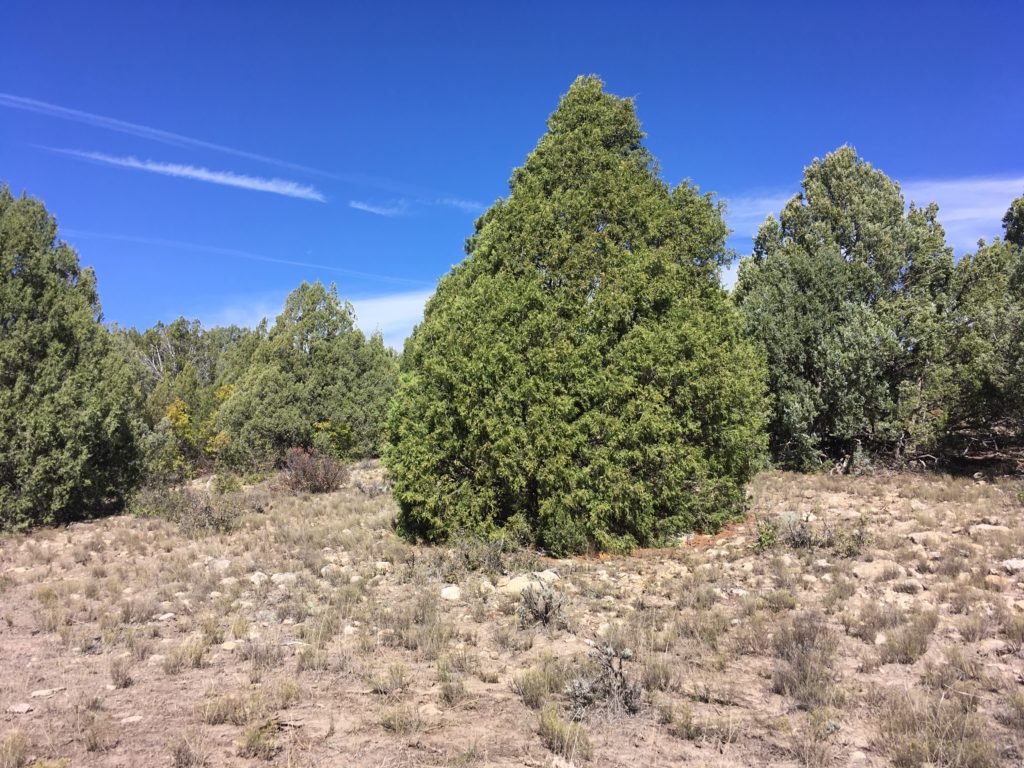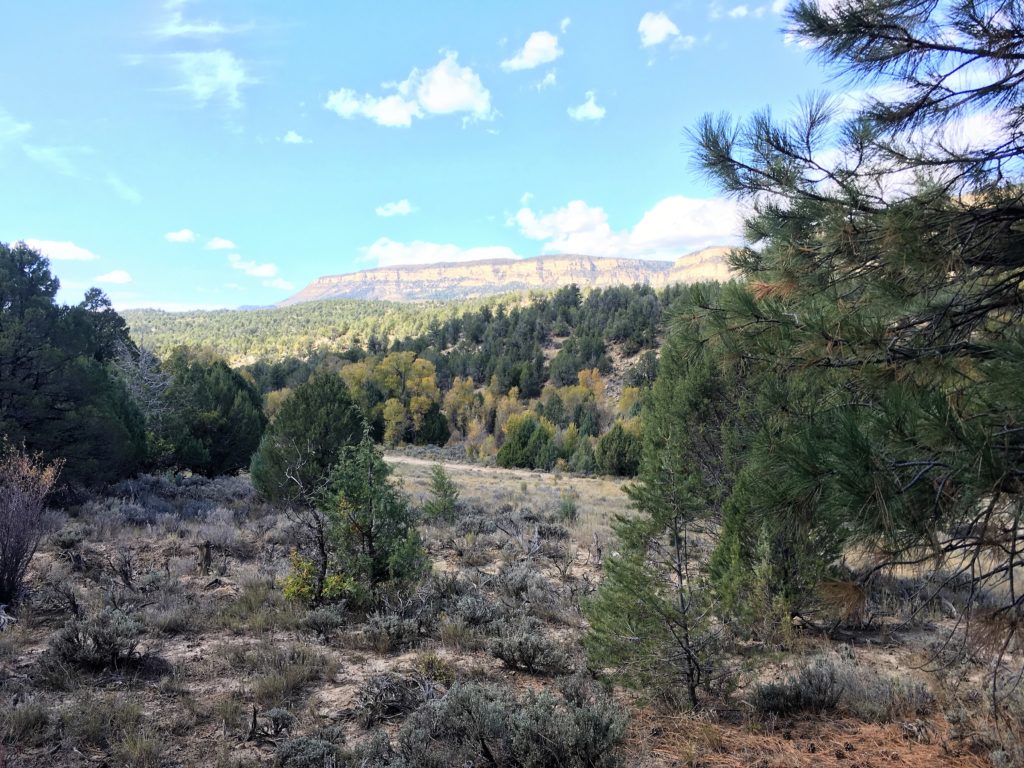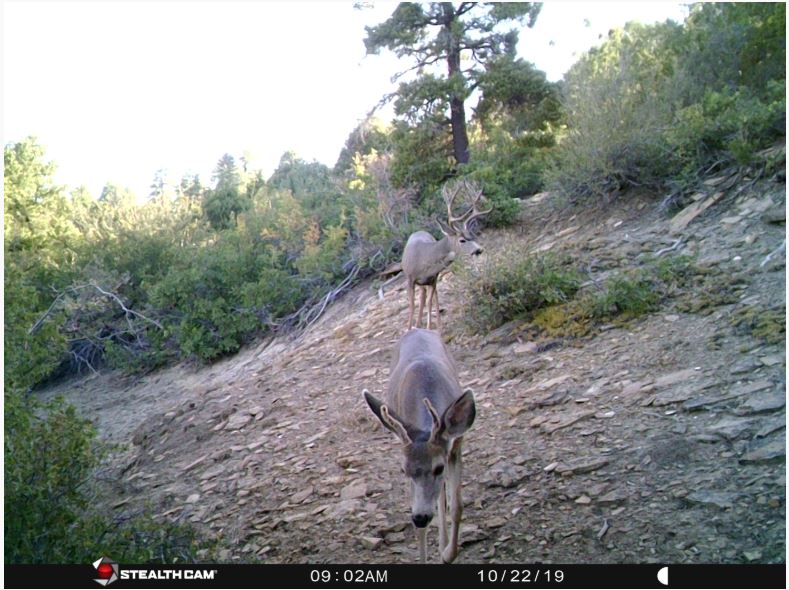ST. GEORGE — The Utah Division of Wildlife Resources is currently working on a project to decrease elevated levels of E. coli in the North Fork of the Virgin River by removing juniper pinyon trees and seeding areas in the uplands to encourage livestock to congregate away from the river.
The project, Hogs Heaven Watershed Enhancement, is on approximately 2,076 acres of private land in Kane County, and its overall initiatives include improving the watershed, range conditions, wildlife migration corridor and wildlife habitat, as well as decreasing levels of E. coli.
Elevated levels of E. coli were first detected in the North Fork about 10 years ago, and according to the project proposal have since been liked to fecal bacteria from livestock and wildlife by the Utah Division of Water Quality. The presence of E. coli poses a threat to recreational uses in the river and could potentially contaminate drinking water further downstream.
The Virgin River has also seen a toxic algal bloom this year.
Clint Wirick, a fish and wildlife biologist for the the U.S. Fish and Wildlife Service, told St. George News that while elk and mule deer use this area as a transitional range, livestock production is the primary use of this private land. And the lack of forage drives livestock to the irrigated pastures along the riparian area.
For livestock to just be “sitting on the river year after year, it’s just not a good thing,” he said.

The goal is to increase the amount of available forage away from the North Fork riparian area by mulching pinyon juniper trees and planting seeds for perennial grasses and forbs away from the riparian habitat.
“It’s private land – it’s going to be grazed regardless – so we’re trying to do good things for livestock at the same time we can do for wildlife,” he said. “A big part of it is trying to get those cows to utilize those uplands more and stay off the river. Give them options, I guess. Because right now the river is the best option.”
Arial seeding in the area has already been initiated and they are in the process of mastication, for which they are using heavy equipment with “big masticating heads.”
“That costs more but in the end, it’s kind of worth the cost,” he said. “Those chips – it’s good organic matter. It helps build soil; it shapes the soil. It kind of gives the seeds a safe place under there. It retains moisture.”
Whether there is a secondary source of water from the river, Stan Gurley, a farm bill biologist for the Division of Wildlife Resources, told St. George News that there are three ponds on the south side of the North Fork, and then “at least two” on the north end.
“They are kind of seasonal sources and runoff dependent, but they have held water while the livestock are there for a number of years. Only in the worst years are they dried up,” Gurley said, adding that they have discussed options with both landowner for putting up potential fencing to further keep the livestock away from the river, but that has only been a discussion.
The seeding was spread near one of the ponds in a sagebrush flat, where the edge of the water to the trees is approximately 50 to 100 yards. That is where they will be grinding.

Gurley said it’s not their goal to go into an area and force it to become a grassland but rather take historical sagebrush or mountain brush habitats through an “ecological succession” or what would’ve happened naturally before things such as historic overgrazing disrupted the natural process.
Without fire or human intervention, Gurley said the pinyon juniper ends up choking out other species until it reaches what they refer to as a Phase 3 Pinyon Juniper.
“It’s extremely thick. We’ve lost the understory. You’re seeing soil erosion under the trees,” he said. “Removing the pinyon juniper is allowing livestock and other wildlife other places to forage and utilize other than the riparian habitat.”
In choosing the seeds, Gurley said they chose species that would do well in these areas and support the ecological community. The reason for putting the seed down first is so when they grind up the trees, the seed gets worked into the soil and is underneath the mulch.
“These are perennial grasses and forbs, so once they’re established, they’ll be there for a very long time. Granted, with droughts and with other climatic events, or with fire, you could lose some of those species,” he said. “But we hope to have enough of a community built up that if there was a fire that did disturb it enough, there would be seed that would be stored.”
If they have rangeland seeds, they typically don’t declare failure until after three years, he added. There is a potential that they would have to reseed in the case of a failure, and they would reseed.
“That’s our goal: to make healthy watersheds, not going and removing a bunch of trees and have problems.”
After the mulching process, livestock will be removed from the treated areas for a two-year period to allow for two growing seasons so the species can establish.
Solving a ‘contentious relationship’
According to the project proposal, this project also serves as a way to solve a “contentious relationship” between landowners and land managers.
Wirick said, in response to this issue, that the contention refers to a lack of grazing opportunities for both the livestock and wildlife.
“When grazing opportunities are limited, it’s hard for them (landowners) to watch the elk and the deer eat the forage,” he said. “They see wildlife in direct competition to them making money off the land, being able to generate an income. The more we work with landowners on opening up grazing areas for wildlife and livestock, the more options there are, the more areas there are for them to graze their livestock, so they’re a little more tolerant to wildlife.”
As this area has been identified as critical mule deer migration habitat, working with private landowners has been essential toward improving big game migration and winter habitat, he said.
The danger of E. coli contamination
The North Fork of the Virgin River is listed as a High Priority 303(d) water body because of elevated levels of E. coli. As defined by the Environmental Protection Agency, this listing refers to section 303(d) of the Clean Water Act, which requires impaired or endangered waters to be identified, listed and issued a priority ranking.
Amy Dickey, a representative for the Utah Division of Water Quality, said the North Fork Virgin River was listed in 2010 for failing to meet the E. coli standard that supports safe recreation.

E. coli live in the intestines of warm-blooded animals and are thus present evidence of fecal contamination when found in bodies of water, she said. And while most strains of E. coli are harmless, the division monitors E. coli as its presence could be indicative of other more harmful waterborne pathogens.
Recreational water illnesses are caused by bacteria, viruses and parasites in the water. These waterborne pathogens can cause diarrhea, vomiting, cramps, fever and rashes. People can be exposed if they swallow water while swimming or recreating. One area of particular importance relevant to this project is the Narrows hike in Zion National Park, which sees a massive amount of visitation every summer with many people swimming or hiking through the deep pools in the canyon.
The end of the road in Zion National Park at the Temple of Sinawava is also incredibly popular for adults and children alike playing when it’s hot in the summer. Because of the potential public health risk to a large number of people, the North Fork of the Virgin River was prioritized for study. The study was completed in 2018.
Intensive monitoring results show that eliminating grazing on pastures being actively flood irrigated, properly managing human waste and improving irrigation water management has led to improved water quality in the North Fork Virgin River watershed, Dickey said.
The implementation of water quality improvement projects and data collection will continue with the hope of removing the North Fork Virgin River from the 303(d) list of impaired waters.
‘Manipulating the system’
Utah Forest Program Director for the Grand Canyon Trust Mary O’Brien told St. George News that while the initiative to try to decrease elevated levels of E. coli is needed, this project is “manipulating the system” to support too many hoofed animals.

“I think it’s basically shoring up excessive numbers of cattle and deer and elk and sheep,” she said. “You’ve got the landowner who wants to be grazing the domestic livestock. You’ve got the Utah Division of Wildlife Resources who want lots of deer and elk.”
As an illustration of the imbalance already taking place in the area, O’Brien referenced a 2006 study on the Narrows that pertains to the intricacies of food webs. Due to the large amounts of people visiting the area for so many years, cougars are gone from the Narrows. And in the absence of cougars, deer have been preventing any new cottonwood from growing by eating the sprouts.
Comparatively, she said, the North Creek nearby, where it’s not so accessible to humans, has cougars and no issues with the growth of cottonwoods.
With this particular project, she said it’s basically planting a crop for an “agricultural operation” that is too focused on how to maximize populations and keep as many elk, deer and livestock grazing.
“This is private land, they get to seed exotic pasture grasses as much as they want, but then they’re sending these elk and deer on into Zion. It isn’t part of the National Park Service to be a farm, to be an ungulate farm,” she said. “And it’s all amid climate change. It’s all amid drought …. It’s just too much for the system; it’s too much for a natural system.”
O’Brien also pointed out that in the project’s focus on juniper taking water, that one pinyon juniper tree can drink up to 30 gallons of water a day. Yet, on a hot day, a cow can also drink up to 30 gallons a day.
While riparian areas comprise about 2% of the land in the west, about 80% of all wildlife in the surrounding area use the riparian area for part or all of their life history, they are now expecting it to support the cattle and the livestock industry.
“They’re not focusing on the number of animals they’re trying to support and farm for in a drying environment. Never in that whole project do they look at the numbers, never question whether the land can sustainably support these numbers,” she said. “They don’t want to look at that. We humans want too much. We want to take too much.”
Click here for full details of the project.
Click on photo to enlarge it, then use your left-right arrow keys to cycle through the gallery.
Map shows area where the Hogs Heaven Watershed Enhancement Project is taking place, location and date unspecified | Photo courtesy of the Department of Natural Resources, St. George News Photo illustrates a location nearby where similar initiatives have been implemented, Kane County, Utah, date unspecified | Photo courtesy of Stan Gurley, St. George News Photo illustrates a location nearby where similar initiatives have been implemented, Kane County, Utah, date unspecified | Photo courtesy of Stan Gurley, St. George News Photo illustrates a location nearby where similar initiatives have been implemented, Kane County, Utah, date unspecified | Photo courtesy of Stan Gurley, St. George News Photo illustrates a location nearby where similar initiatives have been implemented, Kane County, Utah, date unspecified | Photo courtesy of Stan Gurley, St. George News




Copyright St. George News, SaintGeorgeUtah.com LLC, 2020, all rights reserved.

